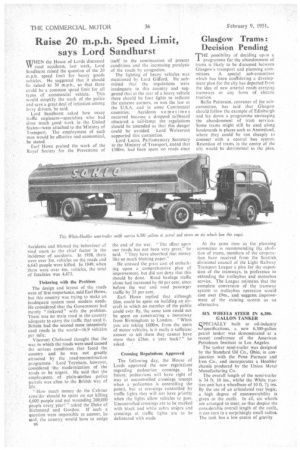Raise 20 m.p.h. Speed Limit, says Lord Sandhurst
Page 40

If you've noticed an error in this article please click here to report it so we can fix it.
WHEN the House of Lords discussed IN road accidents, last week, Lord Sandhurst raised the question of the 20 m.p.h. speed limit for heavy goods vehicles. He suggested that it should be raised to 30 m.p.h., so that there could be a common speed limit for all types of commercial vehicle. This would simplify the work of the police and save a great deal of irritation among lorry drivers, he said.
Lord Sandhurst asked how many traffic engineers—specialists who had done much good work in the United States—were attached to the Ministry of Transport. The employment of such men would be effective and economical, he stated.
Earl Howe praised the work of the Royal Society for the Prevention of Accidents and blamed the behaviour of road users as the chief factor in the incidence of accidents. In 1938, there were over 3m. vehicles on the roads and 6,643 people were killed. In 1949. when there were over 4m. vehicles, the total of fatalities was 4,473.
Tinkering with the Problem The design and layout of the roads were of first importance, said Earl Howe, but this country was trying to make an inadequate system meet modern needs. Be considered that the Government had merely " tinkered " with the problem. There was no main road in the country adequate to carry the traffic that used it. Britain had the second most intensively Used roads in the world-16.9 Vehicles per mile. • Viscount Chelwood thought that the way in which the roads were used caused the serious conditions that faced the country and he was not greatly attracted by the road-reconstruction programme. Lord Teynham, however, considered the modernization of the roads to be urgent. He said that the employment of plain-cilothes .police patrols was alien to the British way of life.
"How much money do the Cabinet cons'eler should be spent on not killing 6,000 people and not wounding 200,000 people every. year? ".asked the Duke of Richmond and Gordon. If such a question were impossible to answer, he said, the country would have to resign
s6 itself to the continuation of present conditions and the increasing paralysis of the roads by congestion.
The lighting of heavy vehicles was mentioned by Lord Gifford. Be submitted that the regulations were inadequate in this country and suggested that at the rear of a heavy vehicle there should be four lights to indicate the extreme corners, as was the law in the U.S.A. and in some Continental countries. Accidents so me t i me s occurred because a dropped tailboard obscured a tail-lamp; the regulations should be amended so that this danger could be avoided. Lord Wolverton supported this contention.
Lord Lucas, parliamentary Secretary to the Ministry of Transport, stated that £300m. had been spent on roads since the end of the war. "The effect upon our roads has not been very great," he said. "They have absorbed that money like so much blotting paper."
He stressed the great cost of embarking upon a comprehensive plan of improvement, but did not deny that this should be done. Road haulage traffic alone had increased by 60 per cent. since before the war and road passenger traffic by 35 per cent.
Earl Howe replied that although £6m. could be spent on building an dircraft in which no member of the public could ever fly, the same sum could not be spent on constructing a motorway from Birmingham to London. "When you are taking £600m. from the users of motor vehicles, is it really a sufficient answer to tell them they cannot have more than £.26m, a year back?" he asked. '
Crossing Regulations Approved
The following day, the House of Lords approved the new regulation regarding pedestrian crossings. In future, pedestrians will have right of Way at uncontrolled crossings (except when a policeman is controlling the point), but at crossings controlled by traffic lights they will not have priority when the lights allow .vehicles to pass. Uncontrolled crossings are to be marked with black and white zebra stripes and crossings at traffic lights are to be delineated with studs




























































































